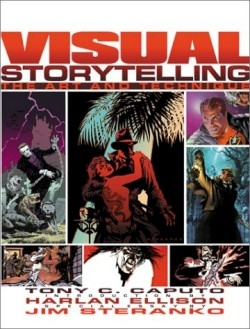Visual Storytelling
Visual media, from comics to anime, interactive video games, and movies, are all ways of telling stories. The process of storytelling is similar, in many aspects, from one medium to another. Here the author, with thirty years’ experience in visual media, has distilled what he knows about the process into a guide that includes everything from drawing to narrative to technique, as well as an essay by Harlan Ellison and sections by other experts.
Profusely illustrated, with examples to demonstrate the proper way to guide the reader’s or viewer’s eye or mind (comic book panels, storyboards, covers, action scenes), the book is invaluable for anyone who wants to understand the mechanism of putting together a game or film. Flowcharts illustrate the steps in the production process; experts discuss everything from figure drawing and perspective to temporal flow, as well as the differences among depth, character, and atmosphere lighting.
Caputo has previously written the best-selling How to Self-Publish Your Own Comic Book as well as hundreds of his own comic books, including Speed Racer, Astro Boy, and The Terminator.
While his new book is by no means a full-fledged technical guide to creating any one of the media discussed, it is an outstanding place to begin, whether the reader wants to create a video game or understand the process that goes into putting together a successful comics adventure. There’s plenty of technical detail guiding the narrative, as in this example about interactive gaming: “if something … included in game play results in imagery changes throughout the game world, there will simply be too many polygons for the machine to draw in at one time, and the game will crash.”
Excellent examples and explanations are provided for everything from conveying time lapse in graphic novels to putting together effective action scenes in movies. The author points out the creative advantages and disadvantages of each medium (comics offer greater artistic freedom, whereas anime, movies, and video games require input from many sources, thus changing the original artist’s concept—sometimes beyond recognition). Caputo also includes quotes from people in the industry, such as Catherine Court, executive producer of Septerra Core, on the impossibility of expecting creativity “on demand,” and filmmaker Kevin Van Hook on the importance of timing in editing.
This is a superb guide to the process of making visual media work. Black-and-white and color examples, film stills, storyboard sketches, and schematics all make abundantly clear the work and creativity involved in making a world realistic enough to draw in the audience, whether in print, on film, or on screen. As the author makes clear, the story guides images, and images can enhance the story, but putting the two together effectively is an art. Those wanting to understand that art better are well served by this book.
Disclosure: This article is not an endorsement, but a review. The publisher of this book provided free copies of the book to have their book reviewed by a professional reviewer. No fee was paid by the publisher for this review. Foreword Reviews only recommends books that we love. Foreword Magazine, Inc. is disclosing this in accordance with the Federal Trade Commission’s 16 CFR, Part 255.

